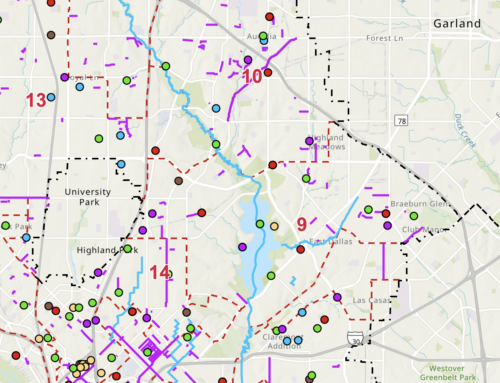I think most of us would agree that we live in a pretty desirable part of town. Otherwise, why would we be here? Many of the most attractive features of East Dallas — the symmetry of the front porches on Munger Place, the gently curving streets in Lakewood, the parks interspersed with our neighborhoods, or the preservation of historic homes, to name a few — are the direct result of good planning. This planning is done not just by individual property owners, but over decades by the city and its staff of professional urban planners.
These are the folks who come up with the ideas, which then get translated into ordinances: what uses are permitted where, how high buildings can be built, how far they have to be set back from the street and from each other, how much parking is needed, how many trees and how much landscaping you need, what kind of signs you can have and many other things. Some of the ordinances apply more to commercial properties, but those, too, have a major impact on how our neighborhoods look, how they maintain their value and generally on our whole quality of life.
Planning lapses over the years, on the other hand, have also had an impact, and often a negative one. Take the example of one of the blocks on Munger Place that has a 1960s apartment building plopped down in the middle of it. Or the friction between some of the businesses on
Greenville Avenue and their nearby neighbors. Better long-range planning could have alleviated some of these problems.
The city’s planners are among those anonymous civilian employees — unlike the better known and very visible police and firefighters — whom you never really talk to or think about until you’re directly affected by their work. Right now, there’s some question about which direction the planning department will go in the city’s next budget cycle.
Many people think that the department is already short-handed, and there is talk of further reductions, perhaps by attrition as planners leave for higher-paying cities or even the private sector, or maybe by a “reduction in force.”
As you can imagine, this affects the workload and the morale of the planners who remain, since there is a steady volume of zoning cases, variance applications and other things that have to be dealt with on a timely basis.
Each one of these cases is more complicated and time-consuming than you might guess, and each one takes a lot of staff time and attention to detail. Fewer planners means less time spent on each case, which could eventually have an impact on the quality of the outcome in some instances.
And as for long-range and comprehensive planning, the kind that comes up with a long-term vision for a whole neighborhood, this has always gotten short shrift in Dallas . If there are fewer and less experienced planners, the shrift will get even shorter, because planners will be in reactive mode dealing with the day-to-day individual cases.
So next time you go to a budget town hall meeting, pause to think a moment about the city’s planning staff. They aren’t heroic figures like the police and the firefighters, and they’re not even as visible as the librarians, the code enforcers or the streets and sanitation crews, but they have a lot more to do than you might think with your property value and your quality of life.





